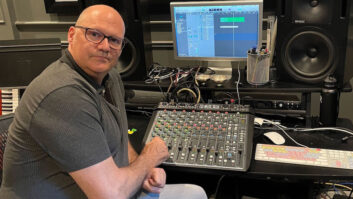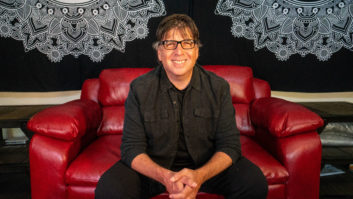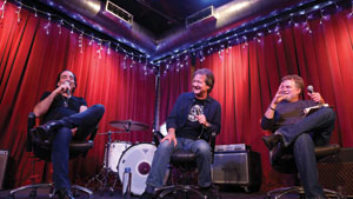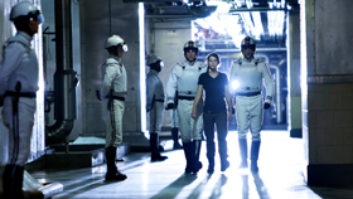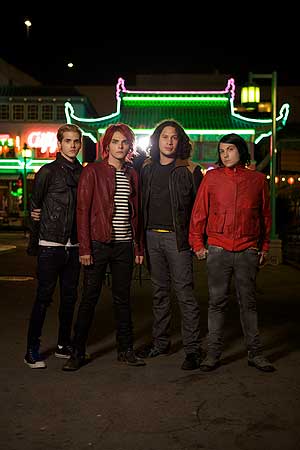
From left: Mikey Way, Gerard Way, Ray Toro and Frank Iero
Photo: Neil Krug
It’s been four years since My Chemical Romance (MCR) released their massively popular, death-obsessed concept album, The Black Parade, which firmly established the theatrical L.A.-based band (originally from New Jersey) as master purveyors of their own idiosyncratic blend of punk, pop, metal and alternative styles. They’ve been compared to everyone from Queen to Smashing Pumpkins to Pink Floyd to Green Day, but there’s no question that MCR also have their own unique vision and approach, thanks in large part to their restless and endlessly creative leader, Gerard Way, an artist-turned-singer/songwriter whose imagination is always stoked by his visual inclinations and for whom the term “high concept” is never an understatement.

Take MCR’s latest album, Danger Days: The True Lives of the Fabulous Killjoys. It is a collection of tunes that are loosely linked by an overarching story about a band (The Killjoys) in the year 2019 and their battles with evil corporate types and laser-wielding baddies in vampire masks known as Draculoids. (This is either ironic or exploitative, given the fact that MCR loudly turned down the opportunity to place a track on the The Twilight Saga: New Moon soundtrack and closes Danger Days with a pointedly critical song called “Vampire Money.”) There are already big-budget conceptual videos for a couple of the catchier tunes on Danger Days out there (“Na Na Na” and “SING,” both featuring lots of laser-gun action, chases and barely comprehensible mayhem), and Gerard Way is also working on a graphic-novel version of the story—the one-time intern at DC Comics’ Vertigo imprint previously won a prestigious comics award with Brazilian artist Gabriel Bá for their work on a series called The Umbrella Academy.
It wasn’t supposed to be like this. When the band got home from two years of touring behind the gaudy, Rob Cavallo–produced Black Parade—a giant production that took them all over the world and left them crispy around the edges—they were determined to bang out a simpler, more stripped-down rock ’n’ roll album this time ’round. They went into the studio with Brendan O’Brien (STP, Pearl Jam, Rage Against the Machine, Springsteen, et al) and did exactly that—but were seized by second thoughts once the album was mixed and essentially done. Something didn’t quite feel right to the band, so they turned back to Cavallo and engineer Doug McKean (who had worked on Black Parade and many of Cavallo’s productions, including Green Day’s American Idiot and discs for the Goo Goo Dolls, Avril Lavigne and many others) to help rework a couple of songs.
“Initially, they asked, ‘Can you help us mix this?’” says Cavallo, who in addition to being a top-flight producer is now also the chairman of Warner Bros. Records, MCR’s label. “I said, ‘No, because it’s already mixed; it sounds fine.’ ‘Well, can we cut some new tunes?’ I said, ‘Absolutely, we can do that.’ And once we started cutting new songs, that was pretty much it. Then they realized there was a difference in terms of the kind of vibe we were getting together. Then that led to them re-cutting the whole record. But I did not go in with the idea of re-cutting the album.”
Adds McKean (who’s now a staff engineer for Warner Bros.), “The band was definitely vocal about wanting to experiment more than they had [on the earlier sessions] and more than they had on Black Parade. They wanted to do the process in a really different way. On Black Parade, they went to a rehearsal room, and I was there for a little bit of it recording their rehearsals, and a lot of songs were completely written before they came into the studio [Eldorado Sound] and then just elaborated on. For this record, they came in wanting to experiment on a couple of songs they’d already written, but it turned into them writing a whole bunch of new songs in the studio from scratch.”

Engineer Doug McKean
That process can go either way, I mention to McKean. “Yes, it can,” he replies, “but these guys were great. In fact, it was actually the best experience I’ve ever had of people writing songs in the studio because that can really bog down. And one reason it went so well is there’s no one guy in the band who is the musical boss, so to speak—they all have a lot of input. Ray [Toro, lead guitarist] is definitely a leader in that band, and Frank [Iero, guitar] has his own vibe of what he wants to do, as does Mikey [Way, Gerard’s bassist brother], and, of course, Gerard usually has ideas of what he’s looking for.”
“The writing would turn into the record immediately—all in one shot,” Cavallo elaborates. “Somebody would come up with a riff or sing something, and we’d just start putting it together. At the demo stage, it might be, ‘Here’s a single guitar track,’ or, ‘Here’s a drum loop,’ or, ‘Here’s how the piano’s going to go,’ or, ‘Ray has the riff—let’s get John [Micili, a top studio drummer who replaced MCR skinsman Bob Bryar a few days into the Cavallo/McKean sessions] to play the drums and get Frank and Mikey in here now.’ There was no rhyme or reason to it. Anybody could start anything, and if it was good, we turned it into a song. We probably had 30 song starts that were brand-new things, and some of the ones that didn’t get fully developed this time are things I imagine we’ll go and get for the future because there were a lot of cool things we left by the side that didn’t fit in with this record but are still really good. But if we caught the momentum on something, we’d dig in and finish it.”

Producer Rob Cavallo
“Sometimes Gerard would be sitting in the back of the control room with headphones fiddling around with a keyboard,” McKean adds. “We might even be working on a different song and he’d be listening to sounds, and he’d just say, ‘Hey, I have this idea I want to put down so we don’t forget it,’ and I’d record one little thing and then the other guys might come in and kind of jam on an idea for a while and that would become the track or part of the track. On a lot of the initial jams, we took some parts and edited them and sometimes re-recorded them, and then later someone might say, ‘Great, I want this new section to have a different beat,’ or something, and it would grow organically out of that process.”
This time out, the album was recorded in Cavallo’s state-of-the-art home studio, known as Lighting Sound, in Hidden Hills, northwest of downtown L.A. Cavallo says the studio boasts a nice-sounding live room, measuring about 20x15x12, with wood floors, no parallel surfaces and diffusers on the ceiling above where the drums are placed. “Allen Sides helped me out with that room,” he notes. The control room “probably has the biggest, most loaded Pro Tools system you’ve ever seen; every card is filled, we’ve got all the cool plug-ins. At the same time, we have all the greatest outboard gear—every mic pre anyone could ever want, including an assortment of old Neves—1073s, V76s—and API 550As and Bs, plus old analog compressors like the RCA ’50s-era ones, the Presto [6A] lathe-cutting compressors, new versions of some of the old Beatles stuff like the Chandler.”
McKean, who helped Cavallo equip the studio, notes, “I owned a lot of vintage gear so I came in with a ton of vintage mics and I have an old Neve console—a Melbourne Series broadcast board—and really esoteric compressors, and Rob had a ton of instruments and amplifiers. Rob is like a genius guitar guy, and he and Ray work together really well. There are a lot of different colors of guitars through different effects, and a lot of layers, but it’s really important to him that you can still hear the character of each sound and it’s not just a big mush. We also had a lot of interesting keyboards on this album.”
Indeed, one of the signatures of Danger Days is the extensive and highly imaginative use of various keyboards throughout the album, from piano (sometimes played by Cavallo) to old analog synths to more modern instruments. Jamie Muhoberac—who was in a prog-rock band with Cavallo nearly 30 years ago, and has worked on Cavallo productions on and off for nearly 20 years—is credited for “keyboards and sound design” because of his large role on the album. “He can play anything,” the producer says. “His taste is fantastic and he really does special things every time.” McKean adds, “He’s all over the record, and in some cases I actually premixed his parts [before the final mix]—like on ‘The Only Hope for Me Is You,’ that would have started with about 40 tracks of keyboards just for that intro and I would have premixed it down to something like eight stereo pairs.” Super-mixer Chris Lord-Alge, who also worked on The Black Parade, once again did the final polishing for Danger Days at his studio, Mix L.A.
Asked whether the wild and futuristic story concept ultimately affected the sonics of the album, Cavallo says, “Definitely! Gerard described for me this world of the future and all these different chaos theories about what the world had come to—sort of post-World War III—and he wove a really interesting story with this band from that time. So we did start to say, ‘We’re this band from the future,’ and we imagined ourselves being in that world, dealing with these issues. So that’s why there are those sounds. We were using our imagination. We’re in the year 2019. What kind of sounds would we make?
“They were really into experimenting and that made it a lot of fun. They were saying, ‘We don’t want to have any limitations of what we can do to make a rock record. We want it to be danceable and we’re not afraid of electronics and synthesizers in rock.’ So that’s why you’re hearing that.”
“They want to go with whatever feels good,” McKean adds. “They’re not afraid to do really poppy things. There are definitely some bands that never want to have that element in their music, but these guys don’t seem to have any of those sorts of hangups. They were up for everything.”
